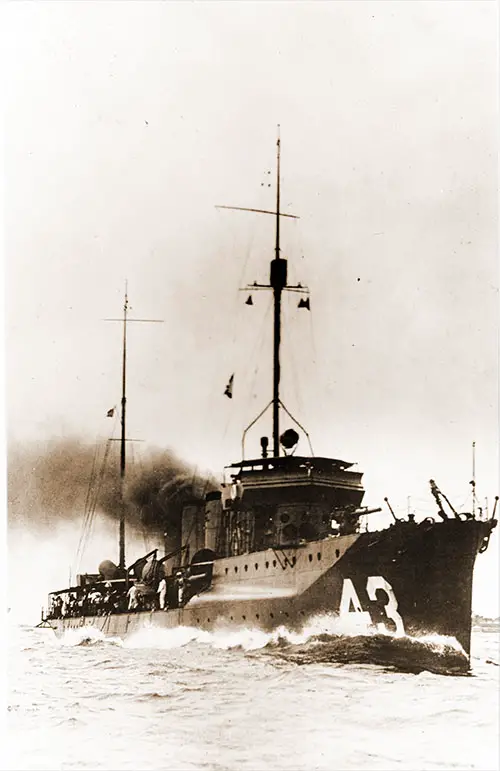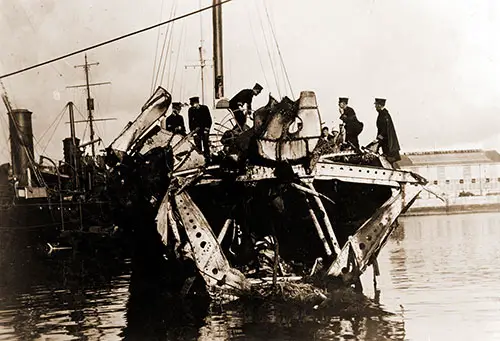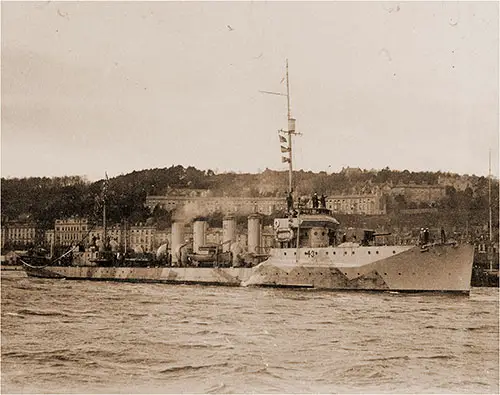"Cassin," Hit by Torpedo, Saved by Quick Action - 1917

The USS Casin (DD-43) on Maneuvers circa 1916. Naval History and Heritage Command NH 76057. GGA Image ID # 17fcd09d0f
The American destroyers operating in the war zone had been on constant duty for seven months before the first and only one sunk by enemy submarine, the Jacob Jones, was torpedoed. Of 592 tons displacement, the little Chauncey had been, on November 19th, sunk in collision with a British transport, 18 lives being lost.
The USS Cassin (DD-43) was struck by a torpedo from the German submarine U-61 on 15 October 1917, but was taken to port and repaired. But one man was killed, Gunner's Mate Osmond K. Ingram, who gave his life to save the ship.
To commemorate this courageous act, Secretary Daniels named one of the new destroyers the Ingram. Commander W. N. Vernou was in command of the Cassin, which was patrolling off the Irish coast about 20 miles south of Mine Head when, at 1:30 P. M., a submarine was sighted some distance away. The Cassin went at full speed for the spot, but the submarine had submerged.
What occurred afterward is told in the official report:
"At about 1:57 P. M., the commanding officer sighted a torpedo shortly after it had been fired, running near the surface and in a direction that war estimated would make a hit either in the engine or fire room. When first seen, the torpedo was between 300 and 400 yards from the ship, and the wake could be followed on the other side for about 400 yards.
The torpedo was running at high speed, at least 35 knots. The Cassin was maneuvering to dodge the torpedo, double emergency full speed ahead, having been signaled from the engine room, and the rudder put hard left as soon as the torpedo was sighted. It looked for the moment as though the torpedo would pass astern.
When about 15 or 20 feet away, the torpedo porpoised, completely leaving the water and sheering to the left. Before again taking the water, the torpedo hit the ship well aft on the port side about frame 163 and above the waterline. Almost immediately after the torpedo explosion, the depth charges, located on the stern and ready for firing, exploded. There were two distinct explosions in quick succession after the torpedo hit.

View of Damage After German Submarine U-61 Torpedoed the USS Cassin (DD-43) on 15 October 1917. She Is Shown Here While under Repairs in England. Naval History and Heritage Command NH 55059. GGA Image ID # 17fd57e2e8
Gave His Life To Save His Ship
"But one life was lost. Osmond K. Ingram, gunner's mate first class, was cleaning the muzzle of No. 4 gun, target practice being just over when the attack occurred.
With rare presence of mind, realizing that the torpedo was about to strike the part of the ship where the depth charges were stored and that the setting off of these explosives might sink the ship, Ingram, immediately seeing the danger, ran aft to strip these charges and throw them overboard.
He was blown to pieces when the torpedo struck. Thus Ingram sacrificed his life in performing a duty that he believed would save his ship and the lives of the officers and men on board.
"Nine members of the crew received minor injuries.
"After the ship was hit, the crew was kept at general quarters.
"The executive officer and engineer officer inspected the parts of the ship that were damaged and those adjacent to the damage. It was found that the engine and fire rooms and after magazine were intact and that the engines could be worked; but that the ship could not be steered, the rudder having been blown off and the stern blown to starboard.
The ship continued to turn to starboard in a circle. In an effort to put the ship on a course by the use of the engines, something carried away which put the starboard engine out of commission.
The port engine was kept going at slow speed. Being absolutely unmanageable, the ship sometimes turned in a circle and at times held an approximate course for several minutes.
"Immediately after the ship was torpedoed, the radio was out of commission. The radio officer and radio electrician chief managed to improvise a temporary auxiliary antenna.
The generators were out of commission for a short time after the explosion, the ship being in the darkness below.
Submarine Again Sighted
"When this vessel was torpedoed, there was another United States destroyer, name unknown, within signal distance. She had acknowledged our call by searchlight before we were torpedoed.
"After being torpedoed, an attempt was made to signal her by searchlight, flag, and whistle, and the distress signal was hoisted. Apparently, through a misunderstanding, she steamed away and was lost sight of.
"At about 2:30 P. M., when we were in approximately the same position as when torpedoed, a submarine conning tower was sighted on the port beam, distant about 1,500 yards, ship still circling under the port engine—opened fire with No. 2 gun, firing four rounds. The submarine submerged and was not seen again. Two shots struck very close to the submarine.
"At 3:50 P. M., U. S. S. Porter stood by. At 4:25 P. M., wreckage which was hanging to stern dropped off. At dark stopped the port engine and drifted. At about 9 P. M., H. M. S. Jessamine and H. M. S. Tamarisk stood by. H. M. S. Jessamine signaled she would stand by until morning and then take us in tow. At this time sea was very rough, wind about six or seven (34 or 40 miles an hour) and increasing.
"H. M. S. Tamarisk prepared to take us in tow and made one attempt after another to get a line to us. Finally, about 2:10 A. M., October 16, the Tamarisk lowered a boat in rough sea and sent grass line by means of which our 8-inch hawser was sent over to her. At about 2:30 A. M.
Tamarisk started towing us to Queenstown, speed about 4 knots, this vessel towing well on the starboard quarter of Tamarisk, due to condition of stern described above. At 3:25, hawser parted.
"Between this time and 10:37 A. M., when a towing line was received from H. M. S. Snowdrop, various attempts were made by the Tamarisk and two trawlers and a tug to tow the Cassin. An 11-inch towing hawser from the Tamarisk parted. All ships, except her, lost the Cassin during the night.
The Cassin was drifting rapidly on a lee shore, and had it not been for the Tamarisk getting out a line in the early morning; the vessel would undoubtedly have grounded on Hook Point, as it is extremely doubtful if her anchors would have held.
35 Feet of Stern Blown Off
"About 35 feet of the stern was blown off or completely ruptured. The after living compartments and after storerooms are completely wrecked or gone, and all stores and clothing from these parts of the ship are gone or ruined. About 45 members of the crew, including the chief petty officers, lost practically everything but the clothes they had on.
"At the time of the explosion, there were a number of men in the after compartments. How they managed to escape is beyond explanation.
"The officers and crew behaved splendidly. There was no excitement. The men quietly went to their stations and remained there all night, except when called away to handle lines.
"The work of the executive officer, Lieutenant J. W. McClaran, and of the engineer officer, Lieutenant J. A. Saunders, is deserving of special commendation.
These two officers inspected magazines and spaces below decks and superintended shoring of bulkheads and restating of masts.
Lieutenant (junior grade) R. M. Parkinson did excellent work in getting an improvised radio set into commission. W. J. Murphy, chief electrician (radio), and F. R. Fisher, chief machinist's mate, are specifically mentioned in the commanding officer's report for their cool and efficient work.
"Twenty-two enlisted men are mentioned by name as conspicuous for their coolness and leadership.
"From the statement of all the officers, it is evident that luck favored the submarine. The destroyer probably would have escaped being hit had not the torpedo broached twice and turned, decidedly to the left both times—in other words, failed to function properly.
850 Pounds of TNT Exploded
"The equivalent of 850 pounds of TNT is estimated to have exploded in and upon the Cassin's fantail; this includes the charges of the torpedo and of both depth mines.
No. 4 gun, blown overboard, left the ship to port, although that was the side which the torpedo hit. The gun went over at a point well forward of her mount. The mass of the wreckage, however, went to starboard.
The explosion of the depth charges, rather than that of the torpedo outward or in a throwback, supposedly affected this. About five seconds elapsed between the torpedo's detonation and those of the mines. They probably went off close together, for accounts vary as to whether there were in all two or three explosions.
"The miracle by which the twenty-odd men in the three wrecked after living compartments escaped with only minor injuries is most striking in the case of F. W. Kruse, fireman, first class. He was asleep in his bunk on the port side, only a few feet forward of the torpedo's point of impact into the storerooms.
Four frames, 84 inches of side, were disrupted immediately alongside his body. He made his way through each of the three compartments, climbed the ladder to the main deck, in a state of unconsciousness, and did not regain his mind until he had gone forward as far as No. 4 stack. His duty was in No. 2 fireroom, which it is believed his subconsciousness was urging him toward.
"Others caught below in the crew space probably did their duty of dogging the water-tight doors from a like cause and in a similar state. The two doors leading into the after compartment, and the door between the C. P. O.'s (chief petty officers') quarters and the engine-room P. O.'s (petty officer's) quarters were all found firmly and perfectly dogged.
Yet all the men escaping up the ladder from this deck declared that they had been absolutely blinded from the first instant of the explosion. Seven men were in the after space, and about the same number in each of the two others.

The USS Cassin (DD-43) Shown in Camuflag Leaving Queentown (Cobh), Ireland for Home, 1918. Naval History and Heritage Command NH 1380. GGA Image ID # 17fd66900d
Bulkhead Shored With Mattresses
"Of the two after doors, that to port threatened to carry away soon after the seas began to pound in. The main mass of the wreckage which dropped off did so upward of an hour after the explosions. It was at this time that the bulkhead began to buckle, and the port door and dogging weaken. It was shored with mattresses under the personal direction of the executive.
Up to this time and until the seas began to crumple the bulkhead completely, there were only a few inches of water in the two P. 0. compartments, and even when the Cassin reached Queenstown, hardly more than three feet.
None of the compartments directly under these three on the deck below—handling room, magazine, and oil tanks—were injured at all. The tanks were farthest aft and were pumped out after docking.
"One piece of metal entered the washroom and before coming to rest completely circled it without touching a man who was standing in the center of the compartment. Another stray piece tore a 6-inch hole in one of the stacks.
"The destroyer within signal distance at the time of the attack was the U. S. S. Porter. It is believed that she saw the explosion, at least of the two depth charges, and thinking that the Cassin was attacking a submarine, started off scouting before a signal could be sent and after the radio was out of commission."
John Wilber Jenkins, "Cassin," Hit by Torpedo, Saved by Quick Action," in Our Navy's Part in the Great War, New York: John H. Eggers Company, Inc., 1919, pp. 21-24.
